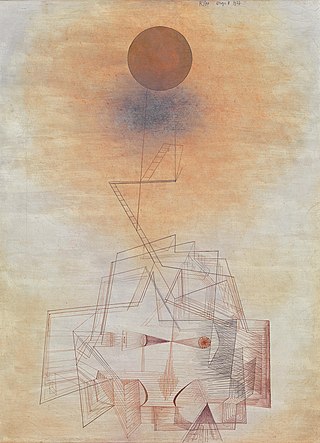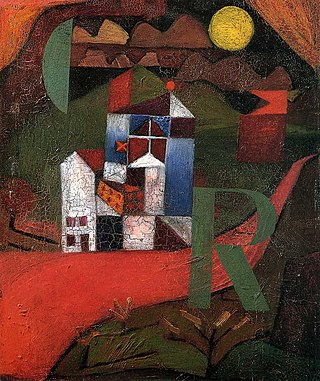
Paul Klee was a Swiss-born German artist. His highly individual style was influenced by movements in art that included expressionism, cubism, and surrealism. Klee was a natural draftsman who experimented with and eventually deeply explored color theory, writing about it extensively; his lectures Writings on Form and Design Theory, published in English as the Paul Klee Notebooks, are held to be as important for modern art as Leonardo da Vinci's A Treatise on Painting was for the Renaissance. He and his colleague, Russian painter Wassily Kandinsky, both taught at the Bauhaus school of art, design and architecture in Germany. His works reflect his dry humor and his sometimes childlike perspective, his personal moods and beliefs, and his musicality.

The Kunstsammlung Nordrhein-Westfalen is the art collection of the German Federal State of North Rhine-Westphalia, in Düsseldorf. United by this institution are three different exhibition venues: the K20 at Grabbeplatz, the K21 in the Ständehaus, and the Schmela Haus. The Kunstsammlung was founded in 1961 by the state government of North Rhine-Westphalia as a foundation under private law for the purpose of displaying the art collection and expanding it through new acquisitions.

The Zentrum Paul Klee is a museum dedicated to the artist Paul Klee, located in Bern, Switzerland and designed by the Italian architect Renzo Piano. It features about 40 percent of Paul Klee's entire pictorial oeuvre.

The Kunstmuseum Basel houses the oldest public art collection in the world and is generally considered to be the most important museum of art in Switzerland. It is listed as a Swiss heritage site of national significance.
The idea of founding a theory of painting after the model of music theory was suggested by Goethe in 1807 and gained much regard among the avant-garde artists of the 1920s, the Weimar culture period, like Paul Klee.

Paul Klee Notebooks is a two-volume work by the Swiss-born artist Paul Klee that collects his lectures at the Bauhaus schools in 1920s Germany and his other main essays on modern art. These works are considered so important for understanding modern art that they are compared to the importance that Leonardo's A Treatise on Painting had for Renaissance. Herbert Read called the collection "the most complete presentation of the principles of design ever made by a modern artist – it constitutes the Principia Aesthetica of a new era of art, in which Klee occupies a position comparable to Newton's in the realm of physics."

Twittering Machine is a 1922 watercolor with gouache, pen-and-ink, and oil transfer on paper by Swiss-German painter Paul Klee. Like other artworks by Klee, it blends biology and machinery, depicting a loosely sketched group of birds on a wire or branch connected to a hand-crank. Interpretations of the work vary widely: it has been perceived as a nightmarish lure for the viewer or a depiction of the helplessness of the artist, but also as a triumph of nature over mechanical pursuits. It has been seen as a visual representation of the mechanics of sound.

Death and Fire, known in German as Tod und Feuer, is an expressionist painting by Paul Klee, from 1940. It is on display at Zentrum Paul Klee, in Bern.

Camel (in Rhythmic Landscape with Trees) (German: Kamel (in rhythmischer baumlandschaft)) is a painting by Swiss artist Paul Klee, made in 1920, in the collection of the Kunstsammlung Nordrhein-Westfalen in Düsseldorf, Germany.

Limits of Reason is a 1927 painting by Paul Klee (1879-1940). It is in the permanent collection of the Pinakothek der Moderne—Pinakothek of modern art—in central Munich's Kunstareal.

Ad Parnassum is a pointillist painting by Swiss-born artist Paul Klee. The painting is currently in the Kunstmuseum Bern.

Fish Magic is a 1925 Surrealist painting by Swiss-German artist Paul Klee. The painting belonged to the collection of Walter and Louise Arensberg before being donated in 1950 to the Philadelphia Museum of Art where it is currently held.

Villa R is an oil-on-carton painting from 1919 by the Swiss-born German artist Paul Klee.

In the Magic Mirror is an abstract oil painting produced in 1934 by the Swiss-based German artist Paul Klee. It is now in the collection of the Art Institute of Chicago.

Insula dulcamara is an oil painting on newsprint pasted to burlap by the Swiss-based abstract artist Paul Klee, initiated in 1938 when he was suffering from the wasting disease scleroderma. It is his largest work and part of the collection of the Zentrum Paul Klee in Bern.
8 Pieces on Paul Klee is the debut album of the Ensemble Sortisatio. It was recorded in February and March 2002 in Leipzig, Germany and in August 2002 in Lucerne, Switzerland. It was released in 2003 by Creative Works Records.
Has Head, Hand, Feet and Heart is a watercolor by Paul Klee painted in 1930. It is held at the Kunstsammlung Nordrhein-Westfalen, in Düsseldorf, which acquired this painting in 1960 with the collection of the Pittsburgh entrepreneur G. David Thompson.

Highway and Byways is an oil on canvas painting by German artist Paul Klee. It belongs to the group of his numerous layer and stripe paintings and was created in January 1929 after Klee's second trip to Egypt. On loan from Werner Vowinckel, it was first exhibited in the Wallraf-Richartz Museum in Cologne and can now be seen in the Museum Ludwig, also in Cologne.

Cat and Bird is a painting by Swiss German painter Paul Klee, created in 1928. It was made when Klee was a teacher at the Bauhaus Dessau. The painting depicts the wide face of a stylized cat with a small bird perched on its forehead. It is held in the Museum of Modern Art, in New York.
















